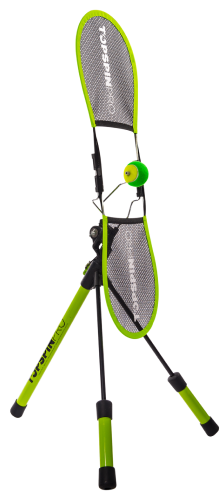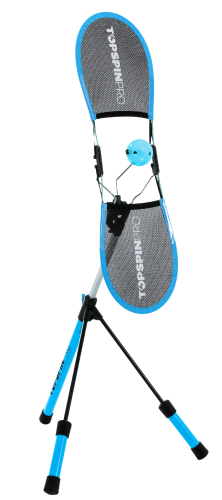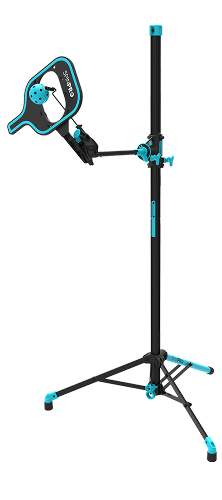 spinpro
spinpro
What we'll cover in this article:
Stay in the loop!
Want to be updated when we publish? Be sure to sign up for our newsletter. No spam, we promise!
Mastering Spin: The Power of Isolated Practice
The Pickleball SpinPro is a valuable tool for isolating and mastering the biomechanics of slice and topspin. By practicing spin in isolation, without the pressure of an incoming ball, you can focus on repeating the correct technique until it becomes second nature. This repetition builds the muscle memory essential for fast and effective progress.
Learning spin—or any new skill—in a high-pressure environment like a match can be frustrating and slow. By isolating the skill and practicing it in a controlled setting, you allow yourself the time and space needed to truly grasp the mechanics. The more complex the skill, the more critical it is to break it down and practice it in isolation.
However, once you've developed a solid foundation through isolated practice, it's crucial to gradually introduce more challenging situations. Jumping straight from isolated practice to full match play can lead to disappointment when you struggle to apply what you've learned. Like any skill, mastering spin requires you to practice under increasingly demanding conditions before you can confidently use it in a game.
The training progressions outlined below will guide you from your initial work on the SpinPro to applying your skills in match play. By following these steps, you'll see the fastest and most effective improvement in your topspin game.
Practice Stages
Stage 1: Building Muscle Memory with the SpinPro
This stage is critical for establishing a strong foundation in your spin technique. It's where you'll spend the most time, ensuring that the correct muscle memory is deeply ingrained. Repetition is key, so resist the urge to rush through this phase. Mastering the basic spin shape is essential before moving on to more advanced practice.
Start by rolling your hand up the back of the ball for topspin or down for slice to get a feel for the topspin action. Once you're comfortable with this motion, transition to using your paddle. Focus on generating a good amount of spin. The goal is to roll the paddle up or down the ball without touching any other part of the SpinPro device. If you can do this while keeping the paddle face parallel to the screens, as shown in the images below, you're off to a great start!
If you find yourself struggling to avoid touching other parts of the device, go back to using your hand or slow down your movements. It's important to build this foundation correctly before advancing to larger swings. Once you're consistently making clean contact with only the ball, you can begin to take fuller swings while maintaining your spin technique.

Stage 2: Static Hits with a Ball
After building sufficient muscle memory with the Pickleball SpinPro, it's time to transition to hitting with a ball.
Drop Feeds
Start with drop feeds to incorporate spin into your shots. There are two types of drop feeds you can practice:
- Bounce and Hit: Drop the ball, let it bounce, and then hit it like a groundstroke.
- Strike Out of the Air: Drop the ball and hit it before it touches the ground, similar to a serve or volley.
Practicing both methods is essential, as spin is used in various situations. When drop feeding, ensure the ball is dropped far enough in front of your body to create an optimal contact point. You might need to toss the ball slightly upward to help it bounce higher or give yourself more time to strike it out of the air.
For added practice, alternate between using the SpinPro and hitting actual balls to reinforce muscle memory.
Slow Ball Static Hits
Have a friend, family member, or coach throw slow balls directly to you so you can focus on applying spin without having to move your feet. This is more challenging than a drop feed and helps build confidence in your spin technique against an incoming ball. Once you’re comfortable, ask your partner to gradually increase the speed of their feeds and throw the balls from a greater distance. This will help you develop the ability to apply spin under slightly more dynamic conditions.
Stage 3: Incorporating Movement
At this stage, you should be confident in your ability to consistently apply spin to the ball. If you find yourself struggling when the pressure increases, don't hesitate to revisit the earlier stages or use the SpinPro between sets to reinforce your technique.
Slow Ball Feeds with Movement
Begin by having your feeder send the ball to different areas of the court, requiring you to move to make contact. This adds an element of difficulty and pressure, simulating more realistic match conditions. Focus on maintaining your spin technique while aiming to get a high percentage of your shots over the net and in the court.
Varied Practice
To further develop your spin skills, practice from different areas of the court and work on a variety of shots. This will help you adapt to different situations and build versatility in your game. Have your feeder throw a mix of shots so you can practice spin on both forehands and backhands.
Faster Ball Feeds and Ball Machine Drills
Once you’re comfortable with movement, progress to faster ball feeds. A ball machine can be particularly useful at this stage, as it provides consistent and adjustable feeds at higher speeds. This allows you to practice maintaining spin at a faster pace, helping you prepare for the speed and intensity of match play.
Stage 4: Rallying
This is where the real challenge begins. Rallying introduces a much greater variety of incoming balls, requiring quick footwork and adaptability to handle changes in height, depth, and pace. You'll need to adjust your own shot placement, speed, and spin with every hit, making this the most dynamic stage of practice. This is where you should dedicate the most time, as mastering spin in such varied conditions demands patience and repetition.
Expect some initial struggles as you adjust to the unpredictable nature of rallying. To build consistency, incorporate a range of shots into your practice, including volleys, dinks, groundstrokes, and even using your spin serve to start rallies. To further challenge yourself, set up targets on the court or aim to control the ball into specific areas, adding a layer of precision to your rally practice.
Stage 5: Practice Points
Once you feel confident with your rallies, it's time to put your spin skills to the test in a competitive setting. Start by playing some skinny singles, both in straight lines and crosscourt. This format allows you to hit more balls than you would in doubles and sharpens your accuracy. Don't be discouraged by setbacks—by this stage, your muscle memory should be well-established. Stay calm, trust your technique, and keep practicing.
After gaining consistency in singles, transition to doubles play. Doubles introduces even more unpredictability, so it’s crucial to stay on your toes, ready to react to anything. Continue to rely on your technique and stay relaxed, knowing that your spin skills are now ready for any situation.
Stage 6: Match Play
The final and most rewarding phase—using your spin in a real match! By now, you should feel confident applying spin from any area of the court. As with stage 5, trust in the technique and muscle memory you've developed. This stage is all about smart shot selection. Expect both exhilarating and challenging moments—it's all part of the excitement of match play. If things don’t go as planned, take the time to reflect on what might have gone wrong, and consider scheduling additional practice sessions before your next match to fine-tune your skills.

Academy
Make sure you spend some time looking through our Academy for some great drills videos and coaching tips to help you with your SpinPro practice:
Summary: Don’t Rush the Process
It’s important to remember not to rush through the stages. A common desire among players is to "play against better opponents." While there’s much to learn from facing more advanced players, the downside is that they often hit faster, giving you less time to react and maintain your form. When developing a specific skill like topspin and slice, it’s crucial to build it up gradually. This approach ensures that your technique remains solid and doesn’t falter under pressure.
Even professional players regularly practice with drop feeds and slower-paced hits to perfect their skills. Ironically, by taking your time and mastering each stage, you’ll find yourself improving faster and feeling more prepared for those high-pressure moments on the court.
Enjoyed this article?
Be sure to sign up for our newsletter and we'll keep you up to date about new posts



